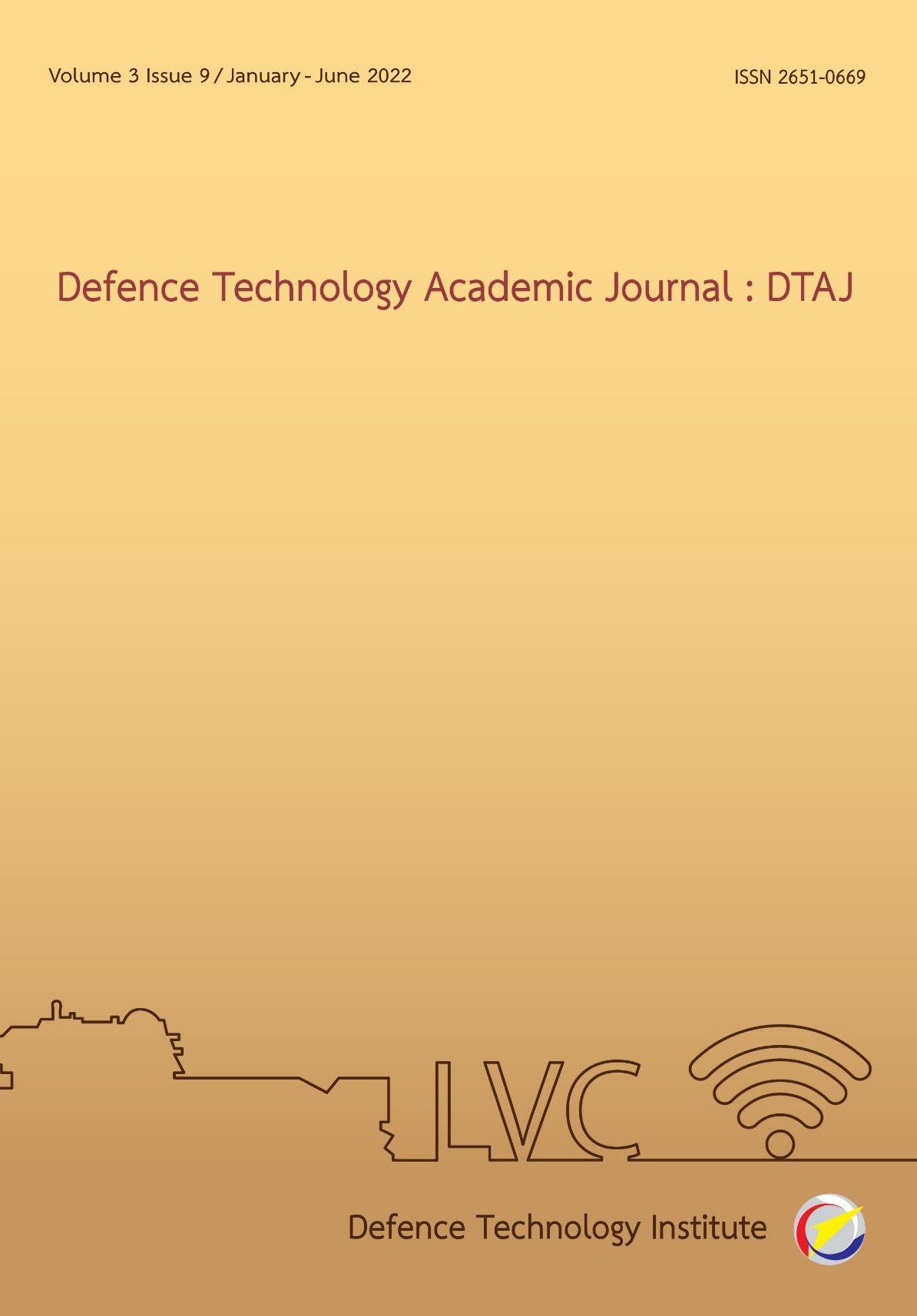Numerical Study of Gas flow and Ablation for Supersonic Nozzle
Main Article Content
Abstract
Developing a highly efficient supersonic rocket propulsion system requires knowledge and understanding of gas flow and ablation at the nozzle. In this research, numerical studies were carried out in that development: Computational Fluid Dynamics (CFD) and Finite Element Analysis (FEA). Using a 122 mm nozzle as a case study in a transient state, CFD revealed a gas flow leading to the shock wave, temperature, pressure, etc., inside the nozzle, consistent with actual static experimental results. The CFD results were applied as conditions for the determination of ablation using the FEA. The FEA results showed the equivalent (von-mises) stress due to the pressure and temperature of the gas flow. Additionally, it was found that the more the stress, the greater the ablation. Consistent with the experiment, the front nozzle had higher ablation than the tail. The finding from this research can be applied to improve the 122 mm and other types of nozzle for higher efficiency with reduction of ablation.
Downloads
Article Details

This work is licensed under a Creative Commons Attribution-NonCommercial-NoDerivatives 4.0 International License.
Journal of TCI is licensed under a Creative Commons Attribution-NonCommercial-NoDerivatives 4.0 International (CC BY-NC-ND 4.0) licence, unless otherwise stated. Please read our Policies page for more information...
References
Prathibha, M., Satyanarayana, M., Naidu, S., “CFD analysis on a different advanced rocket nozzles”, Int. J. Eng. Adv. Tech., 4 (6), 2015, pp. 14-22.
Roy, P., Mondal, A., Barai, B., “CFD analysis of rocket engine nozzle”, Int. J. Adv. Eng. Res. Sci., 3 (2), 2016, pp. 39-46.
Nayeem, S., Chaitanya, S., Krishna, G.M., et al., “Optimization of convergentdivergent taper agle with combustion chamber of rocket engine through numerical analysis”, Int. J. Innov. Tech. Expl. Eng., 9 (6), 2020, pp. 76-81.
Baidya, R., Pesyridis, A., Cooper, M., “Ramjet nozzle analysis for transport aircraft configuration for sustained hypersonic flight”, Appl. Sci., 8, 2018, 574.
Afzali, B., Karimi, H., “Numerical investigation on thermos-acoustic effect and flow characteristics in semi-conical Hartmann-Sprenger resonance tube”, Proc. IMechE. Part G: Aero. Eng., 0(0), 2016, pp. 1-17.
Dangi, D.R., Thaker, P.B., Harichandan, A.B., “Flow analysis of rocket nozzle using method of characteristics”, Proc. 6th ICRTEST, Punjab, India, 8 Jan 2017, pp. 915-922.
Saengo, C., Palsarn, S., Boonpan, A., “Insulation analysis for rocket’s nozzle to reduce deformation of nozzle shape”, 35th ME-NETT, 20-23 Jul 2021, Nakhon Pathom, Thailand, AME0002. (in Thai)
Hui, W.H., Bao, F.T., Wei, X.G., Liu, Y., “Ablation performance of a 4D-braided C/C composite in a parameter-variable channel of a Laval nozzle in a solid rocket motor”, New Carbon Mater., 32 (4), 2017, pp. 365-373.
Gross, P.G., Boyd, I.D., “Reduce reaction mechanism for rocket nozzle ablation simulations”, J. Thermophys. Heat. Tr., 32 (2), 2018, pp. 1-11.
Gross, P.G., Boyd, I.D., “Conjugate analysis of rocket nozzle ablation”, J. Thermophys. Heat. Tr., 56 (5), 2019, pp. 1-22.
Zhang, X., Wang, Z., Wang, R., et al., “Numerical simulation of chemical ablation and mechanical erosion in hybrid rocket nozzle”, Acta Astronaut., 192, 2022, pp. 82-96.
Babu, G.V., Murphy, V.B., “Prediction of thermal ablation in rocket nozzle using CFD and FEA”, Int. J. Comp. Mater. Sci. Eng., 9 (3), 2020, 2050014.
ANSYS Inc., “How fluid-structure interaction works and why it’s important”, Available: https://www.ansys.com/blog/fluid-structure-interaction-explained (accessed on 10 May 2022)
Huc, N.,“Conjugate heat transfer”, Available: https://www.comsol.com/blogs/conjugate-heat-transfer/ (accessed on 10 May 2022)
Narayana, K.P.S.S., Reddy, K.S., “Simulation of convergent divergent rocket nozzle using CFD analysis”, IOSR J. Mech. Civil Eng., 13 (4), 2016, pp. 58-65.
Deshpande, N.D., Vidwans, S.S., Mahale, P.R., et al., “Theoretical and CFD analysis of De Laval nozzle”, Proc. 4th IRF Int. Con., Punc, 16 Mar 2014, pp. 61-64.
Patel, M.S., Mane, S.D., Raman, M., “Concept and CFD analysis of De Laval nozzle”, Int. J. Mech. Eng. Tech., 7 (5), 2016, pp. 221-240.
NASA, “Rocket thrust equation”, Available: https://www.grc.nasa.gov/www/k-12/airplane/rockth.html# (accessed 10 May 2022)
Ansys, Inc., “Fluent theory guide 17.1”, ANSYS, Inc.: Canonburg, PA, USA, 2016.
Khongsin, J., Thongsri, J., “Numerical investigation on the performance of suction head in a cleaning process of hard disk drive factory”, ECTI Trans. Electr. Eng. Electron. Commun., 18 (1), 2020, pp. 28-34.
Puangburee, L., Busayaporn, W., Kaewbumrung, M., Thongsri, J., “Evaluation and improvement of ventilation system inside Low-cost automation line to reduce particle contamination”, ECTI Trans. Electr. Eng. Electron. Commun., 18 (1), 2020, pp. 35-44.
Jansaengsuk, T., Kaewbumrung, M., Busayaporn, W., Thongsri, J., “A proper shape of the trailing edge modification to solve a housing damage problem in a gas turbine power plant”, Processes, 9, 2021, 705.
Thongsri, J. Tangsopa, W., Khongsin, J., “A suitable shape of the suction head for a cleaning process in a factory developed by computational fluid dynamics”, Processes, 9, 2021, 1902.
Ansys, Inc., “Ansys mechanical user’s guide”, ANSYS, Inc.: Canonburg, PA, USA, 2016.


